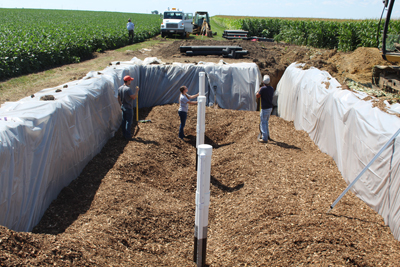
A bioreactor installation in Illinois. Blogger Hannah Dougherty stands next to the middle white pipe. Credit J. Chandrasoma/UIUC
What can a trench filled with woodchips do to improve water quality? The July 7 Sustainable, Secure Food blog explains bioreactors, a solution to nitrogen runoff.
“Denitrifying bioreactors are a low-tech, yet highly sophisticated environmental solution,” says blogger Hannah Dougherty, University of Illinois, Champaign-Urbana. Their design is simple—a trench with woodchips—yet the impact is notable. Bioreactors can remove up to 45% of the nitrogen load in a field’s drainage water.
How does this happen? Dougherty explains: “Soil naturally contains bacteria and other microbes. Bioreactors enhance the natural process of denitrification — the conversion of nitrate in water to harmless nitrogen gas — performed by bacteria already present in the surrounding soil. The woodchips provide an additional fuel source for the bacteria in the form of carbon. Think of the woodchips as an extra cup of espresso in the morning!”
Illinois has a goal of installing bioreactors on half of the state’s tiled agricultural fields. Bioreactors’ success in improving water quality is also creating interest in other states.
“They have great potential for expansion,” Dougherty writes. “While they are not a silver bullet, they do offer important benefits in that they don’t negatively impact in-field crop production.”
To read the complete blog, visit Sustainable, Secure Food at https://wp.me/p9gkW1-2S.





